Lauren Aversa Dr. Licastro ENG 256 2/10/2019
A Comprehensive Rhetorical Analysis of the Esperanza Center
Introduction
The Esperanza Center is an extension of the Catholic Charities of Baltimore. Their mission is to uphold the visions of humility, dignity, compassion, and integrity in collaboration with the city of Baltimore. The Esperanza Center is a resource center for immigrants trying to navigate life in a new country. This paper will analyze the components of the Esperanza Center’s website and how they work together.
Audience
In a rhetorical analysis, you have to pay attention to who the text will be received by (Arola, Sheppard, Ball 23). The intended audience of the Esperanza Center is volunteers, donors, and immigrants. Volunteers and donors are the primary target for the website because they are the main supporters of the charity. There are many opportunities for these people to get involved, including donate and volunteer now buttons. Immigrants are the people who can most benefits from their services. There are many outlets for immigrants to reach out to the center including contact us buttons, addresses, and phone numbers. The secondary audience is Catholics. As the Esperanza Center is a function under the Catholic Charities of Baltimore, it is suiting that this would be a secondary audience. The values each audience holds are humanitarianism, well-being of others, dignity of others, treat people with compassion, act with integrity. The website appeals to these values by providing an opportunity for people to reach out in collaboration and serve the community.
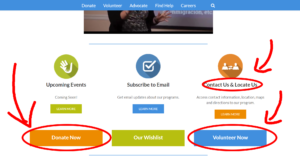
Purpose
A purpose can be communicated in many ways; one of the most commonly used methods is a call to action (Arola, Sheppard, Ball 22). The Esperanza Center’s website utilizes this call to action method with opportunities to get involved. This center considers their purpose to be bringing the community together by offering “English as a second language and other classes, primary medical and dental care, immigration legal services, and general assistance with resources and referrals, family reunification and support immigrant victims of human trafficking.” Their mission is easily accessible through their homepage and throughout their written text. The Esperanza Center shows the amount of people who are and are involved in this organization. They make sure their resources are available for the people who need it. The website serves as an outlet for people to get involved with this organization through donations, volunteer work, and testimonials.
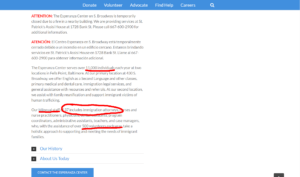
Context
There are many things to consider when analyzing the context of text. The main things you need to consider are the where, how, what of the text, and the social, cultural, and historical connotations within the text (Arola, Sheppard, Ball 24). In this particular case, the Esperanza Center’s website is being analyzed. So, the medium would be the web and this would be chosen because it reaches the broadest audience. By having this information available on the Internet, more people will be reached whether they be the volunteers, donors, or immigrants in need. This site is also mobile-friendly; ultimately, this means that the audience is not restricted to one form or usage of the Internet and it can be accessed at the user’s discretion. This website also reflects on the sociocultural influences in Baltimore. There are more immigrants and people in need in our streets and this websites serves as a service for them and their families. The websites utilizes pictures, colors, and phrases to represent this.

Author
In some rhetorical analyses, finding the author of a piece of text is simple. In this case of the Esperanza Center, the answer is not so clear. A general author of this text would be the Catholic Charities of Baltimore. The Esperanza Center is an extension of this larger organization, the Catholic Charities of Baltimore would be an implied author of the text. If specifics had to be made, Bill McCarthy would be a credible choice. According to the about us section of the Esperanza Center’s website, Bill McCarthy is the executive director. He may not be in charge of writing all the copy for the website, but he is an overseer and would at least have a say in what is used. He is also listed as having his own blog. Under this link there are many articles that he publishes based on current events and personal editorials. His pieces and that of the Esperanza Center are reliable and trust worthy. The reader gets a sense of the reputation the center holds after its many years of service.
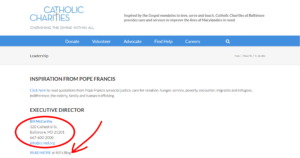
Genre
A genre can help people “recognize how to group similar texts and understand their communicative purposes” (Arola, Sheppard, Ball 27). Genres can be broad but they can also be specific. They can also be influenced by the culture, history, and audience surrounding the text. When analyzing the Esperanza Center’s website, the reader can easily identify that it is a non-profit, charity organization. It is also known that religion plays a factor in the organization. However, what makes this a universal non-profit website is the design and layout of the page. Most non-profits use the same template for website creation. For example, compare the homepage of the Catholic Charities of Baltimore to that of the Behavioral Health System Baltimore. These two non-profits have very similar homepages.
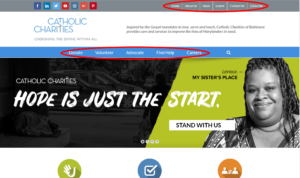
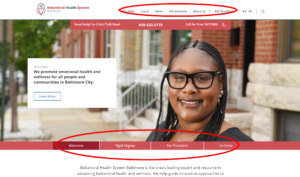
As seen above, the Esperanza Center’s homepage features an about us and learn more option just as the Behavioral Health System Baltimore’s page has done. There are a few differences, but both websites utilize the varying featured photo and content with tabs above and below for more access to the page.
Modes
The Esperanza Center’s website is multimodal. This means it includes visual, spatial, and linguistic modes of communication. Each mode plays a role in the overall message, but the multimodality is what creates the full piece of communication (Arola, Sheppard, Ball 4).
The visual mode looks at the color, layout, and style of the text. The Esperanza Center uses a green, blue, and orange color theme with a sans serif font. This style choice reflects a lot about the personality of the organization. Each of these choices reflect on the culture within the center. They also include pictures of people volunteering and the immigrants utilizing their services. This gives a unique outlook of the charity.
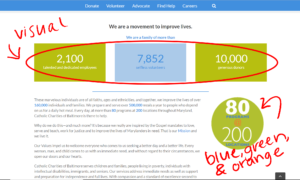
Spatial mode is a unique mode. It focuses on the placement, arrangement, and organization of the text. The proximity of the text and the placement of the visuals all take place in this mode. For example, on the Esperanza Center’s website, is organized so that the reader knows where to direct their eye to obtain vital information.
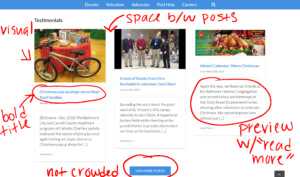
The linguistic mode serves to analyze the word choice and delivery of the text. Essentially, the way the text is written. The Esperanza Center’s website uses this mode to communicate simply and effectively to it’s audience. They even include text written in Spanish for their audience.
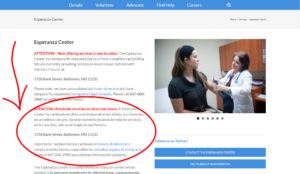
Conclusion
The Esperanza Center’s website features multiple modes of communication including color, organization, and linguistics that adequately reflect that of a non-profit, Catholic, charity. This rhetorical analysis reviews how the site executed it call to action with audience, purpose, context, author, and genre. The site could be made more efficient with better visuals and organization. What the site has is a good start that needs to be refined. The sit could benefit from updating their Esperanza Center landing page. The Catholic Charities of Baltimore has a more refined design and layout whereas the Esperanza Center feels more like a blog post. This Center is a major organization and should be represented as such. Overall the message the Center is trying to convey is received, it could just be done more effectively with these tips.
References
Arola, Kristin L., et al. Writer-Designer: a Guide to Making Multimodal Projects. Bedford/St. Martin’s, 2014.